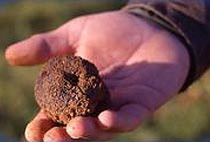Truffles: the Black Diamond of Provence

The truffle season 'officially' opens at the beginning of November. And it's in the Vaucluse, in Richerenches and Carpentras, that the two biggest truffle markets in the world are held: don't be the last in the race for the 'black diamonds'! A noble jewel in the crown of French gastronomy, the truffle - 'rabasse' in Provençal - is the only luxury product sold as is, emerging all covered in earth from the rich soils of Provence, the region that produces 80% of France's truffles. Anyone interested in truffles should remember the 'two-thirds rule': France produces two-thirds of the world's truffles, Vaucluse produces two-thirds of France's truffles and Comtat Venaissin produces two-thirds of Vaucluse's truffles.
A mushroom with an enchanting fragrance and exquisite taste

Truffles are hypogeous (living underground), mycorrhizal (needing a host tree, such as the holm and white oaks in Provence) and saprophytic (feeding on decomposing plant matter) fungi. Only four varieties have gastronomic value, the most noble being the 'black diamond' or tuber melanosporum. The "melano" is a globular tuber with black outer skin and black-purple flesh streaked with fine white veins.
Irregularly round, from the size of a walnut to that of a large fist, it gives off an exceptionally bewitching fragrance, well known to connoisseurs.

In the old days, farmers, following a time-honoured tradition, used a pig, which was fond of truffles and could spontaneously locate them ... even if they then had to be prevented from eating them! Nowadays, dogs are more commonly used, as they need to be trained but have the advantage of a sense of smell that enables them to smell truffles from a distance of several metres and a depth of more than thirty centimetres.
Like a fine bloodhound, it scratches the earth a little and leaves it to its master to dig it out with a hook called a "fouji", so as not to damage it with his claws.
The price of truffles on the markets in Provence
Between €100 and €1,000 per kilo on the market!
"If you want to harvest truffles, plant acorns" is a saying coined by Joseph Talon, the first truffle-grower in the Vaucluse region, who in 1810 came up with the famous idea of planting acorns gathered from under truffle oaks.
It was thanks to him that truffle-growing developed in the 19th century: in 1868, for example, the Vaucluse produced 380 tonnes of truffles, collected in particular on Mont Ventoux.
Since then, intensive farming and the use of chemical fertilisers and weedkillers have disrupted the fragile ecological balance in which truffles thrive.
Today, depending on the year, only between 10 and 30 tonnes are harvested. What's rare is what's expensive, and a kilo of truffles can be bought for between €100 and €1,000, with prices rising in the run-up to the festive season because of the increase in demand... but also because of the ever-increasing quality of the truffles, the best of which are found from January onwards, when they ripen to perfection.
Where can I find out more about truffles?
- Read the excellent book"La Magie de la Truffe", recipe book by Christian Etienne, preface by Pierre Gagnaire
- Friends of the black truffle website: http://melano.free.fr/
Where can you taste truffles in Provence?
Here are a few good places to try truffles in Provence:
Where can you find truffles in Provence?
Truffle production extends over 15 communes in the Vaucluse and 68 communes in the Drôme Provençale:
Truffle markets in Carpentras (from mid-November to mid-March, Friday morning), Richerenches (from January to March, Saturday morning) and Valréas (Wednesday morning). Also Aups (Thursday), Chamaret (Monday), Grignan (Tuesday), St-Paul-Trois-Châteaux (Monday), Nyons (Thursday), Taulignan (Saturday), Montségur (Thursday).
Truffle Mass in Richerenches, with an all-truffle meal (every 3rd Sunday in January) in honour of Saint-Antoine, patron saint of truffle growers.
Taste Day in Richerenches, on the 3rd Sunday in October, to coincide with National Taste Week: truffle omelette tastings ...
Maison de la Truffe et du Tricastin (Saint-Paul-Trois-Châteaux): for a list of truffle producers in the Drôme, tel: 04-75-96-61-29.
A few golden rules for eating them:
Cook truffles as little as possible (don't hesitate to eat them raw)
Give truffles time to express their aromas (prepare them at least 12 hours before serving).
Truffles need fat to express themselves: cream, butter and oil trap the truffle's aroma.
Avoid seasonings that are too strong, such as garlic, vinegar or lemon.
Here are a few recipe ideas:
Truffle omelette (ten to twenty grams of sliced truffles per person, macerated with eggs three or four hours beforehand, cooked over a high heat and served slushy).
Truffle butter or cream (shavings of truffles mixed with butter or crème fraîche) to garnish fresh pasta or fish fillets...
Truffle oil (truffle peelings, shavings or sticks macerated in the oil of your choice), which can be kept for ten days in the fridge, can be used to season salads or potatoes.
With olive oil, for example, you can drizzle on mashed potatoes and roast chicken: your guests will remember it for a long time!


